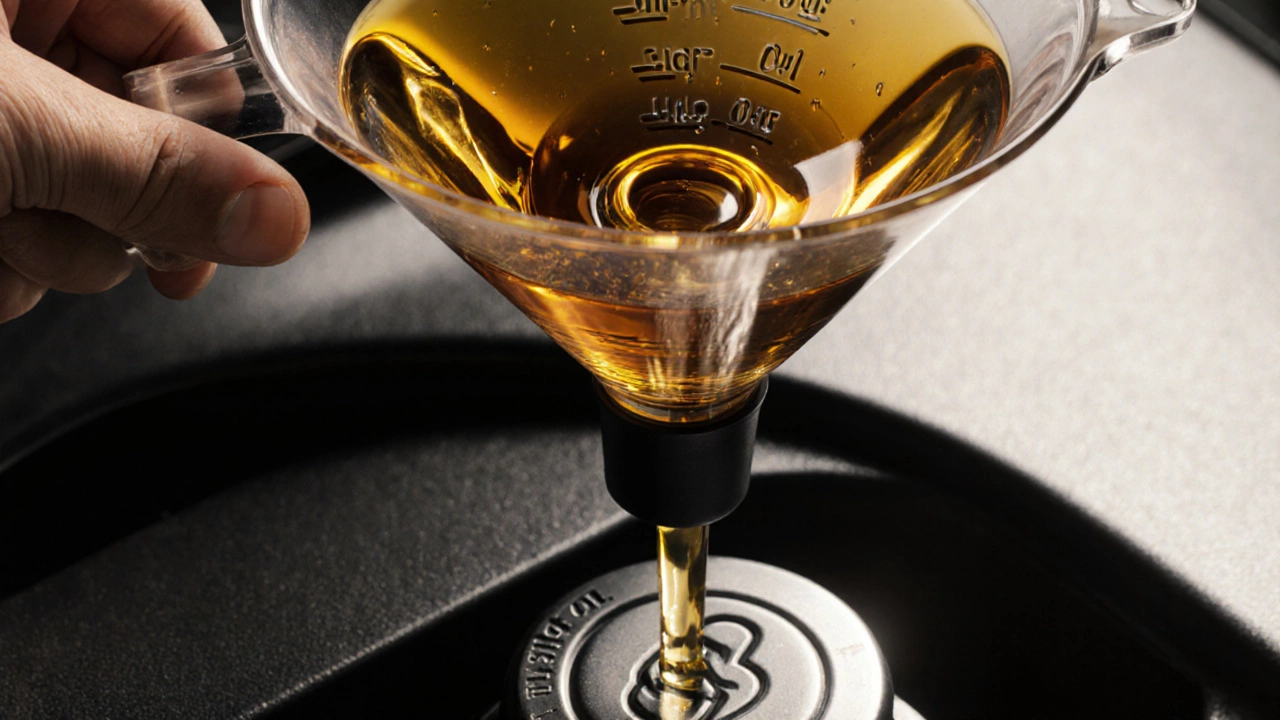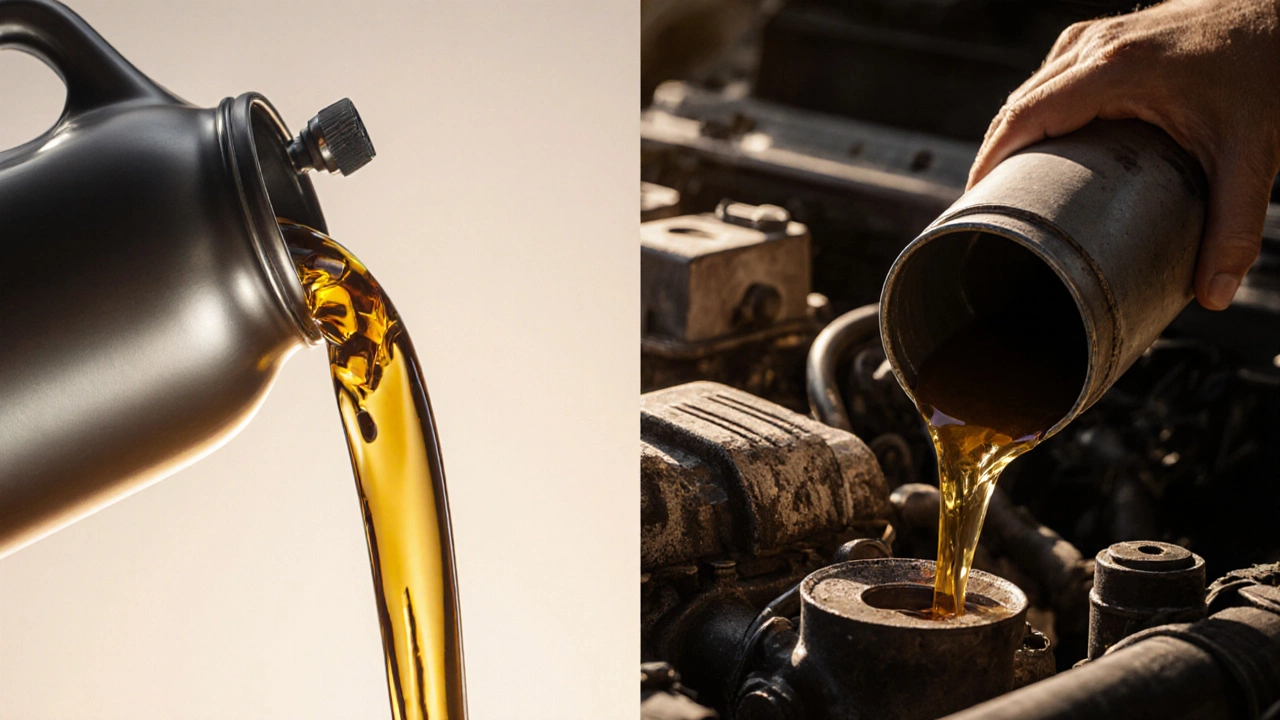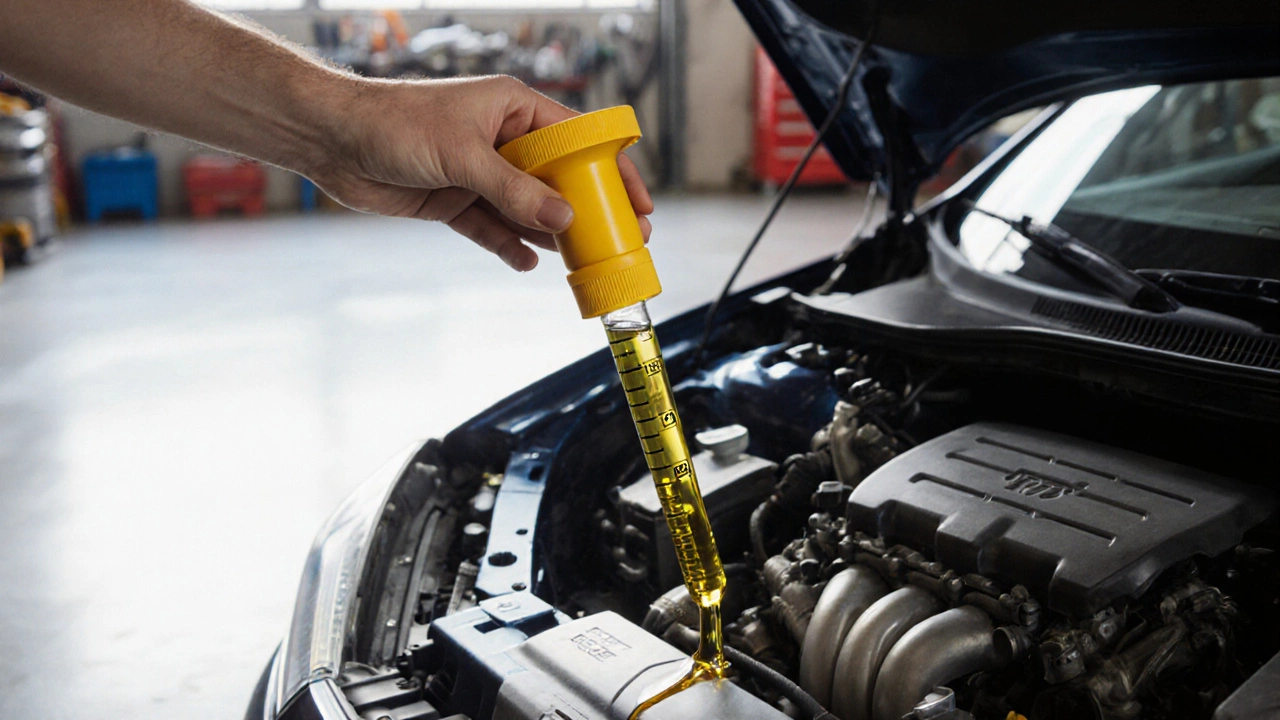Oil Top-Up Calculator
Input Data
Results & Recommendations
Seeing the oil warning light flash or the dipstick show a low reading can make anyone wonder: can I just add oil and be done with it? The short answer is yes-if you do it the right way. The long answer involves knowing why the level is low, what type of oil you’re using, and when a simple top‑up is enough versus when a full change is required.
What engine oil lubricates moving parts inside the engine, carries heat away, and helps seal gaps actually does
Every internal‑combustion car is a collection of metal components that move at high speed relies on a thin film of oil to keep friction and wear in check. As the engine runs, oil picks up heat, circulates through tiny passages, and returns to the oil panthe reservoir at the bottom of the engine that holds bulk oil. Over time, particles, fuel residues, and moisture get mixed in, which is why a regular change is essential.
When a simple top‑up is safe
- You've just checked the dipstick and seen the level between the "Low" and "Full" marks.
- The oil looks clean, without a milky appearance that would signal water contamination.
- You know the exact viscosity grade your engine requires (e.g., 5W‑30).
- The vehicle hasn't been sitting for weeks with a low level, which can cause oil starvation.
If those boxes are ticked, adding the right amount of oil can restore proper lubrication instantly.
Step‑by‑step: How to add oil correctly
- Park on level ground and turn the engine off for at least five minutes. This lets oil settle in the pan.
- Open the oil filler capusually marked with an oil can symbol. If you’re unsure, consult the owner’s manual.
- Using a clean funnel, pour the recommended viscosity gradesuch as 5W‑30, that matches your engine’s specification in small increments-about ¼ litre at a time.
- After each addition, wait a few seconds, then re‑check the dipsticka calibrated stick that indicates oil level. Wipe it clean, re‑insert fully, pull out, and read the mark.
- Stop adding once the oil reaches the "Full" line but avoid over‑filling; excess oil can foam and reduce lubrication.
- Replace the filler cap securely and close the hood.

Why just adding oil isn’t always enough
Adding oil fixes the immediate level, but it doesn’t address the root causes that made the level drop. Common reasons include:
- Oil leaks: A cracked gasket or loose drain plug can let oil escape, meaning the problem will return quickly.
- Burnt oil: Engines that run very hot or have worn piston rings may consume oil.
- Old oil breakdown: After many miles, oil loses its additives, becoming thin and less protective.
If you notice the oil level dipping repeatedly within a short period, it’s time for a thorough inspection-replace the oil filtera cartridge that traps contaminants before oil recirculates and consider a full oil change.
Full oil change vs. top‑up: When to choose each
A full change swaps out old oil, the filter, and often the oil pan gasketthe seal that prevents leaks from the pan. It’s recommended:
- Every 5,000-10,000km (or every 6-12months) depending on manufacturer guidance.
- Whenever the oil looks dark, smells burnt, or has particles.
- After any major repair that required draining the oil.
A simple top‑up is fine for occasional low readings caused by short trips, cold weather thickening, or after a brief oil consumption spike.
Choosing the right oil: Synthetic vs. conventional
| Feature | Synthetic Oil | Conventional Oil |
|---|---|---|
| Viscosity Stability | Excellent across temperature extremes | Degrades in very cold or hot conditions |
| Oil Life (km) | Up to 15,000km | 5,000-7,500km |
| Cost per litre | Higher (£8‑£12) | Lower (£4‑£7) |
| Engine Protection | Superior wear resistance, better sludge control | Adequate for older engines but less robust |
| Best For | Modern high‑performance engines, turbocharged, frequent short trips | Older, low‑performance engines, budget‑conscious owners |
Both types meet the required specifications, but synthetic oil gives you a larger safety margin if you tend to top‑up often. It also reduces the frequency of full changes, which can offset the higher price over time.

Common pitfalls and pro tips
- Never mix different oil grades or brands in the same fill; it can alter viscosity and affect performance.
- Use a funnel to avoid spills that can damage paint or cause fire hazards.
- If your car has an oil level sensoran electronic monitor that triggers warning lights, trust it, but still double‑check with the dipstick for accuracy.
- Keep a spare 1‑litre bottle of the correct oil in the trunk for emergencies.
- Record the date, mileage, and oil type after each top‑up; patterns can reveal hidden leaks.
Following these habits makes a quick top‑up a safe stop‑gap rather than a gamble.
Frequently Asked Questions
Can I use any oil brand for a top‑up?
Stick to the brand and viscosity your owner’s manual recommends. Mixing brands isn’t illegal, but it can change additive balances and affect engine wear.
What if the oil level is below the "Low" mark?
Add oil slowly, re‑checking after each pour. If you need more than half a litre to reach the proper line, investigate for leaks or burning before continuing.
Do modern cars need oil changes as often as older models?
Synthetic‑friendly engines often stretch to 15,000km between changes, but always follow the manufacturer’s interval. Skipping changes can void warranties.
Is it okay to add oil while the engine is warm?
Yes, as long as the vehicle is turned off and you wait a few minutes for the oil to settle. Adding oil to a hot, running engine can cause splashing and burns.
Should I also replace the oil filter after a top‑up?
Not required for a simple level correction, but if you’re approaching the next change interval, swapping the filter is a good preventive measure.
Next steps and troubleshooting
If after a top‑up the warning light stays on, re‑check the dipstick, ensure the filler cap is seated, and look for obvious leaks under the car. Persistent low readings or oil‑colored smoke from the exhaust signal a more serious issue-consult a qualified mechanic.
Keeping a regular schedule for checking the oil, using the correct viscosity, and understanding when a full change beats a quick top‑up will protect your engine and save you money in the long run.
engine oil is the lifeblood of your vehicle; treat it with the care it deserves, and it will keep you moving smoothly mile after mile.

